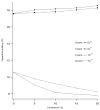A comparative study of the effect of cholesterol on bicelle model membranes using X-band and Q-band EPR spectroscopy
- PMID: 19501076
- PMCID: PMC2719848
- DOI: 10.1016/j.chemphyslip.2009.05.003
A comparative study of the effect of cholesterol on bicelle model membranes using X-band and Q-band EPR spectroscopy
Abstract
X-band and Q-band electron paramagnetic resonance (EPR) spectroscopic techniques were used to investigate the structure and dynamics of cholesterol containing phospholipid bicelles based upon molecular order parameters (S(mol)), orientational dependent hyperfine splittings and line shape analysis of the corresponding EPR spectra. The nitroxide spin-label 3-beta-doxyl-5-alpha-cholestane (cholestane) was incorporated into DMPC/DHPC bicelles to report the alignment of bicelles in the static magnetic field. The influence of cholesterol on aligned phospholipid bicelles in terms of ordering, the ease of alignment, phase transition temperature have been studied comparatively at X-band and Q-band. At a magnetic field of 1.25 T (Q-band), bicelles with 20 mol% cholesterol aligned at a much lower temperature (313 K), when compared to 318 K at a 0.35 T field strength for X-band, showed better hyperfine splitting values (18.29 G at X-band vs. 18.55 G at Q-band for perpendicular alignment and 8.25 G at X-band vs. 7.83 G at Q-band for the parallel alignment at 318 K) and have greater molecular order parameters (0.76 at X-band vs. 0.86 at Q-band at 318 K). Increasing cholesterol content increased the bicelle ordering, the bicelle-alignment temperature and the gel to liquid crystalline phase transition temperature. We observed that Q-band is more effective than X-band for studying aligned bicelles, because it yielded a higher ordered bicelle system for EPR spectroscopic studies.
Figures





Similar articles
-
Electron paramagnetic resonance studies of magnetically aligned phospholipid bilayers utilizing a phospholipid spin label: the effect of cholesterol.Biochim Biophys Acta. 2005 Aug 15;1714(2):141-51. doi: 10.1016/j.bbamem.2005.06.009. Biochim Biophys Acta. 2005. PMID: 16061199
-
Investigating magnetically aligned phospholipid bilayers with EPR spectroscopy at Q-band (35 GHz): optimization and comparison with X-band (9 GHz).J Magn Reson. 2004 Nov;171(1):71-9. doi: 10.1016/j.jmr.2004.08.002. J Magn Reson. 2004. PMID: 15504684
-
Investigating the structural and dynamic properties of n-doxylstearic acid in magnetically-aligned phospholipid bilayers by X-band EPR spectroscopy.Chem Phys Lipids. 2005 Feb;133(2):151-64. doi: 10.1016/j.chemphyslip.2004.09.019. Epub 2004 Oct 30. Chem Phys Lipids. 2005. PMID: 15642584
-
Magnetically aligned phospholipid bilayers with large q ratios stabilize magnetic alignment with high order in the gel and L(alpha) phases.Langmuir. 2005 May 10;21(10):4291-8. doi: 10.1021/la0473005. Langmuir. 2005. PMID: 16032838
-
High-field spin-label EPR of lipid membranes.Magn Reson Chem. 2005 Nov;43 Spec no.:S20-5. doi: 10.1002/mrc.1680. Magn Reson Chem. 2005. PMID: 16235222 Review.
Cited by
-
When detergent meets bilayer: birth and coming of age of lipid bicelles.Prog Nucl Magn Reson Spectrosc. 2013 Feb;69:1-22. doi: 10.1016/j.pnmrs.2013.01.001. Epub 2013 Jan 23. Prog Nucl Magn Reson Spectrosc. 2013. PMID: 23465641 Free PMC article. Review. No abstract available.
References
-
- Aussenac F, Laguerre M, Schmitter JM, Dufourc EJ. Detailed structure and dynamics of bicelle phospholipids using selectively deuterated and perdeuterated labels. 2H NMR and Molecular Mechanics Study. Langmuir. 2003;19:10468–10479.
-
- Borbat PP, Costa-Filho AJ, Earle KA, Moscicki JK, Freed JH. Electron Spin Resonance in Studies of Membranes and Proteins. Science. 2001;291:266–269. - PubMed
-
- Borroni B, Pettenati C, Bordonali T, Akkawi N, Luca MD, Padovani A. Serum cholesterol levels modulate long-term efficacy of cholinesterase inhibitors in Alzherimer disease. Neuroscience Lett. 2003;343:213–215. - PubMed
-
- Budil DE, Lee S, Saxena S, Freed JH. Nonlinear-least-square analysis of slow motion EPR spectra in one and two dimensions using a modified Levenberg-Marquardt Algorithm. J Magn Reson Series A. 1996;120:155–189.
-
- Cardon TB, Tiburu EK, Lorigan GA. Magnetically aligned phospholipid bilayers in weak magnetic fields: optimization, mechanism, and advantages for X-band EPR studies. J Magn Reson. 2003;161(1):77–90. - PubMed
Publication types
MeSH terms
Substances
Grants and funding
LinkOut - more resources
Full Text Sources
Medical

